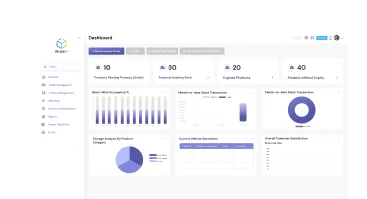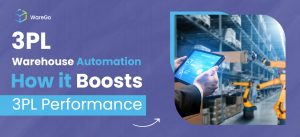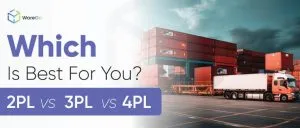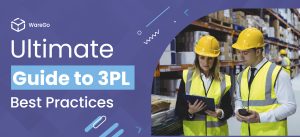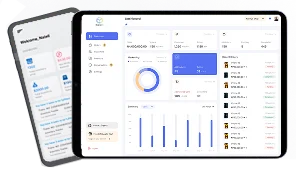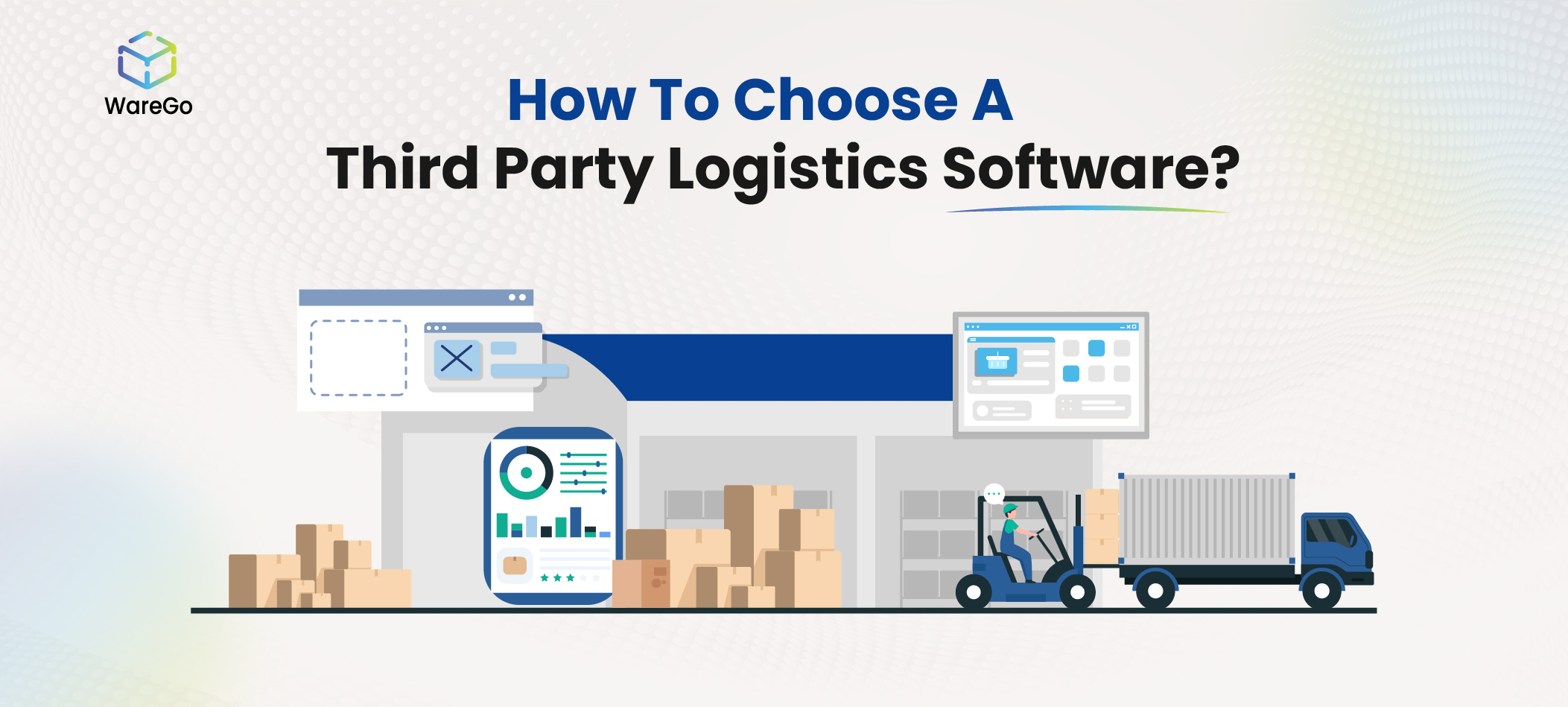
Are you planning to automate your 3PL business operations, but don’t know how to choose third party logistics software?
Well, let us help you out.
3PL businesses struggling with issues such as inventory miscounts, human errors, manual tracking of value-added services, and scattered data across spreadsheets must invest in high-functioning 3PL software.
According to the statistics shared by Verified Market Research, the 3PL warehouse management system market is expected to reach USD 2,254.93 billion by 2032, growing at a CAGR of 8.18%, which indicates the significant adoption of these innovative software solutions by numerous 3PL businesses.
While most businesses are leveraging automation with robust warehouse management software, let’s quickly learn what to check while you choose 3PL solution for your business.
WareGo provides centralized control over shipping, warehousing, inventory management, and order fulfillment in a single system. So, why wait?
Start a Free DemoTable of Contents
What is a Third Party Logistics Software?
Before we move towards how to choose a third party logistics software, let’s quickly learn what it is.
Third party logistics software is a technological solution that helps 3PL businesses manage logistics processes. It includes functionalities like warehouse management, transportation management, order management, and customer relationship management.
With a robust 3PL solution, businesses can manage inventory, freight, and carrier matters from a single dashboard. This helps them automate everyday logistics operations and deliver efficient services to their customers.
10 Key Factors for Choosing a Third Party Logistics 3PL Software
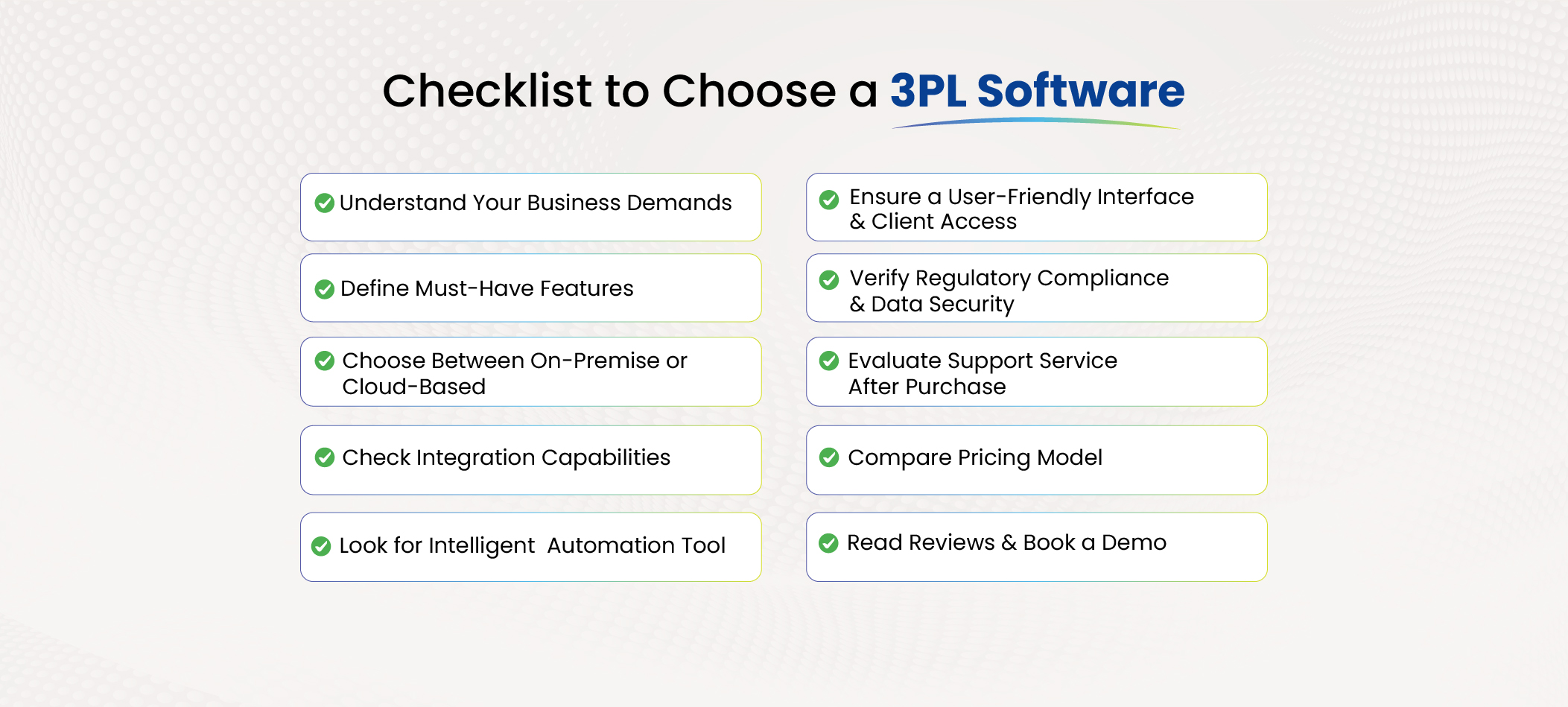
We understand that it can be challenging to select a 3PL software with multiple vendors available. To help you out, we have shortlisted 10 key factors to consider while choosing a software solution for your business.
1. Business Demands
Software solutions are designed to add convenience to your business processes. Therefore, to make a sound decision, identify the core business needs that the software must cater to.
If you already have a software that you are planning to replace, this step will be easier for you. Simply list the gaps and see if the software you are considering addresses them or not.
And if you are getting a software implementation for the first time, consider asking yourself the following questions:
- What 3PL services do we offer? And does the software cater to it?
- How many locations and warehouses do we operate? Can the software offer multi-location handling?
- Do we serve B2B, B2C, or both types of clients? Does the software align?
- What are our biggest pain points? Can software solve them?
- Are we planning to expand the business sooner or later? Is there space for scalability?
With the above question list, you can quickly identify the potential of software for consideration.
To ease the selection, take a free demo of WareGo, a leading 3PL software for small to medium sized businesses.
2. Must-Have Features
While every feature of the 3PL software system is important, some features are essential to making your business operations smooth and efficient.
Check if the software offers:
- Inventory Management
- Automatic Billing
- Value-Added Services
- Labor Management
- Real-time Reporting
- Returns Processing
- End to End System Integration
- Customer Portal
3. On-Premise or Cloud-Based
There are two deployment types for 3PL software. Cloud-based and on-premises. The modern software solution offers cloud-based options, while others are on-premises ones. Based on your budget and needs, choose between these two options.
For your help, here’s a quick On-Premise vs. Cloud-Based software comparison table:
Features | On-Premise | Cloud-Based |
| Setup Cost | High | Low |
| Access | Local Only | Anywhere, Everywhere |
| Updates | Manual | Automatic |
| Scalability | Limited | High |
4. Integration Capabilities
To leverage an interconnected automation experience, your 3PL ecommerce WMS should offer wide integration options or at least integrate with important systems like:
- eCommerce platforms like Shopify, Amazon, WooCommerce
- ERPs such as NetSuite, SAP
- Transportation Management Systems (TMS)
- Accounting Software like QuickBooks, Xero, Etc
- Customer Relationship Management (CRM)
Want a quick tip? Look out for a software that offers open API support for integrations.
5. Intelligent Automation Tools
The primary purpose of 3PL software is to increase automation and reduce manual input, thereby saving time, cost, and minimizing the risk of human errors. Therefore, prioritize a software solution that offers:
- Auto-routing orders to the concerned warehouses
- Auto-generating shipping labels
- Forecasting demand using AI
Let our software experts help you out!
Connect Now6. User-Friendly Design with Easy Client Access
A third party logistics warehouse software must be easy to use for your warehouse team and clients. Select a solution with an intuitive and easy-to-use interface, offers compatibility with handheld devices, has user dashboards that are customizable for different user roles, and offers white-label options to brand client portals.
A user-friendly software system will help you save money on training and allow you to get started immediately.
7. Regulatory Compliance and Data Security
Compliance and security checks are essential before trusting software with your critical business data. We recommend that you request SOC2 and ISO certifications. Check if the software has data encryption and backup functionalities. Also, ensure the software supports industry-specific compliance, such as FDA regulations, and meets the needs of your customers.
Moreover, it often feels unnecessary actually to read the SLAs clients offer. However, for a 3PL software, it’s essential to read them and ensure everything aligns with your needs.
8. Support Service After Purchase
Customer service is more than the introductory call you receive at the beginning of the software purchase. The real support counts when a software vendor offers an end-to-end solution even after the software purchase.
Ask the company if they offer 24/7 customer support, will there will be extra charges for customer support, and how much time it generally takes to resolve queries. These questions may seem unnecessary in the initial stage, but they will ultimately benefit you.
9. Pricing
Before considering 3PL software options, make sure you have a budget in place. Since different software vendors charge differently, you need to select between monthly, annual, order, or tier-based plans. Think thoroughly and evaluate what works best for your budget before making a decision.
To learn more about how much you should pay, read our blog post on 3PL software pricing.
Note: Some vendors cleverly place hidden charges in their packages. We advise you to be cautious of them.
10. Reviews & Demo
Reviews, customer testimonials, and demo programs are first-hand ways to learn about a 3PL or retail warehouse management system. Platforms like G2, TrustPilot, Capterra are great to learn what other third part logistics businesses like you think about the software you are considering.
What Benefits Does a 3PL Software Add to Your Business?
The benefits of 3PL software primarily include:
1. Improved Warehouse Productivity
When your warehouse team manage operations manually, there are chances for errors and less productivity. But with a cloud-native 3PL software, you can leverage detailed analytics and KPI reporting, custom packaging and kitting, and seamless client onboarding to improve your warehouse’s productivity.
2. Effective Cost Management
A software solution offers premium-level automation that surpasses manual input. It automates everyday logistics tasks, optimizes shipping decisions, and reduces the overall cost of operations.
3. Real-Time Operational Visibility
With a 3PL order management software, companies can access real-time data of the fulfillment center, carrier service provider, and inventory management at any time from anywhere.
4. Customer Satisfaction & Loyalty
Customer satisfaction is also a top benefit of investing in a third-party logistics software solution. It helps deliver a high-quality customer service level by adding accuracy to delivery promises with top-notch features, such as order routing and carrier integration.
5. Improved Utilization of Team
With a cold storage WMS, you can manage 3PL warehouse labor in an efficient way. The built-in labor management features will help you assign tasks, track working hours, monitor performance, and identify areas of improvement.
Common Mistakes to Avoid When Choosing 3PL Software
When selecting a wms for your 3PL business, common mistakes that business owners often make include:
1. Choosing a Cheaper Option
Price is an important factor, but prioritizing it over functionality can lead you to choose the wrong software for your business. Most of the time, a cheaper quote is due to low-quality service, hidden costs, or a lack of scalability.
What to do? Before evaluating price, check if the software aligns with your needs.
2. Not Identifying Needs Completely
A software solution is to ease your daily business operations. However, if you invest without understanding your actual needs, there is a risk of making an incorrect decision.
The Solution? Take some time to identify the gaps in your operations, determine which elements need to be automated, and list them down. Then, evaluate the software based on this list.
3. Prioritizing Other Features Over Reporting & Analytics Features
To have clear insights and data about your business is important for making effective decisions. Therefore, purchasing a 3PL software plan with no reporting and analytics features can leave you behind the competition.
How to avoid this? Include reporting and analytics in your list of must-have features to avoid overlooking them.
4. Selecting a Vendor With Poor Communication & Support
The customer service support is often overlooked, but it is a crucial part of your 3PL food and beverage inventory software decision-making process. A vendor with inefficient communication channels and a weak support team can leave you alone in a time of urgent need.
So, what’s next? Look for a vendor appreciated for their customer service and that has efficient communication channels, such as 24/7 chat, call, and email support.
5. Unavailability of Seamless Integrations
All 3PL software comes with integration capabilities, but you need seamless integration, not complex ones. If the software you select offers complex integrations with other software, such as ERPs and CRMs, you are likely to experience bottlenecks, inefficiencies, and service breakdowns.
How to fix it? Opt for wholesale inventory management system for your 3PL business that offers convenient, seamless, and open API integrations.
Why Invest in WareGo As Your Third Party Logistics Software?
WareGo brings a third party logistics software that streamlines complex logistical processes and adds automation and efficiency to your business. We have successfully served 200+ businesses so far with features that help you simplify:
- Receiving processes
- Warehouse and inventory management
- Order fulfillment
- Transport and freight management
- Returning processing
- Reporting and visibility
With a focus on helping businesses manage 3PL operations efficiently and expanding their client base, WareGo is poised to help 3PL businesses outshine the competition and make a lasting mark in the industry.
We offer convenient 3-tiered pricing and a free demo to help our clients stay satisfied with both our pricing and the quality of our service.
Automate Your LogisticsFAQs
What 3PL Software Features Does WareGo Offer?
WareGo is built with 3PL business needs in mind. It offers a comprehensive range of features that include but are not limited to:
- Client Management
- Billing Automation
- API and EDI integrations
- Real time insights
How Much Does WareGo 3PL Software Cost?
WareGo offers three packages for its cloud-based 3PL software. The standard package costs $499 per month, the Pro package costs $779 per month, and the Advanced package costs $ 1,149 per month. Moreover, you can also request custom quotes as per your specific needs.
How Much Implementation Time Does 3PL Software Need?
The time of implementation depends on the size of your business. However, for small to medium-sized businesses, our general implementation time is 2 to 4 weeks. Once the implementation is complete, no further setup time is required, and you can get started instantly.
What is the Best 3PL Software for Small Business?
WareGo is the best 3PL software for small businesses. It offers robust yet unique features, such as a self service client portal, retail label solutions, direct invoice export, and personalized dashboards, that help small business owners experience ease and deliver quality service to their clients.
Which are Top Third Party Logistics Companies?
The top third party logistics companies are:
- WareGo
- Logiwa Technology, Inc.
- Deposco
- Extensiv (formerly 3PL Central)
- Shipium
What Software do Logistics Companies Use?
Logistics companies utilize multiple software solutions to automate inventory management, routing, and scheduling, and enhance overall business efficiency. The common software solutions are:
- Transportation Management Systems (TMS)
- WMS
- Enterprise Resource Planning (ERP) systems
- Wholesale Inventory Management System
